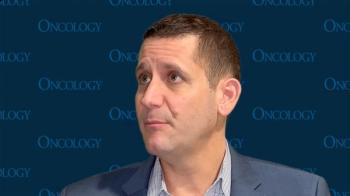
Method of Palliative Care Does Not Affect QOL in Advanced NSCLC
Either telehealth or in-person recipes of palliative care did not impact the quality of life outcomes for patients with advanced non–small cell lung cancer.
For patients who experience video telehealth or in-person care, the outcomes recorded were equally beneficial, according to results from the REACH PC trial (NCT033754890) presented at the
These results “underscore the potential to increase access to evidence-based early palliative care through telehealth delivery,” stated researcher Joseph Greer, Ph.D., associate professor of psychology in the Department of Psychiatry at Harvard Medical School in Boston, during a press briefing at the conference.
“Despite considerable advances in novel therapeutics, most people with metastatic lung cancer will, at some point along the disease course, experience burdensome physical and psychological symptoms as well as impaired quality of life,” Greer said. “To address these unmet needs, national guidelines from ASCO and other professional organizations recommend integrating palliative care from the time of diagnosis of advanced cancer. These guidelines are based on evidence from multiple clinical trials demonstrating the efficacy of early palliative care for improving quality of life, mood symptoms, coping, and other key outcomes in this vulnerable population.
“Unfortunately, most patients with advanced cancer and their families do not receive this evidence-based care due to multiple barriers, chief among them being the limited availability of specialty trained palliative care clinicians and practical issues in accessing supportive care. One promising solution for helping patients overcome obstacles to obtaining medical care is the provision of telehealth using video visits.”
Researchers enrolled 1250 patients with advanced NSCLC diagnosed in the past 12 weeks and 548 of their caregivers from 22 cancer centers across the United States between June 14, 2018, and May 4, 2023, who were randomly assigned 1:1 to receive monthly palliative
care visits either in-person or via video chat, Greer stated. Patient-reported outcome measures were collected at weeks 12, 24, 36, and 48.
Greer said that participants’ average age was approximately 65 years old, slightly more than half of participants were women, and the majority identified as White, non-Hispanic and married.
Patient quality of life was assessed via the Function Assessment of Cancer Therapy-Lung (FACT-L) questionnaire, which has potential scores of 0 to 136, with higher scores indicating better quality of life. The adjusted mean scores at week 24 were 99.7 for the video visit group and 97.7 for the in-person group (difference 2.0; 90% CI, 0.1-3.9; P for equivalence = .04).
Caregiver attendance at visits was reported for 49.7% of the in-person group and 36.6% of the video visit group (difference -13.0%; 95% CI, -17.6% to -8.6%; P < .001). This difference was attributed by Greer as likely being due to the need for family members or friends to accompany patients and assist with their transportation to and from in-clinic visits.
The two groups, Greer noted, did not differ with regard to satisfaction with care or patient mood symptoms.
“These findings are critical evidence to support the ongoing access to telehealth services, especially for vulnerable populations with serious illness,” Greer said, “and will ideally inform policy decisions regarding the role and coverage of virtual care in the future.”
Even still, Greer noted, questions persist regarding the circumstances under which video visits should be considered the preferred modality for the delivery of palliative care, “especially to reduce the burdens of travel costs and risk for infection among potentially immune-compromised or frail patients, as compared to when in person visits are essential.”
Greer suggested the use of follow-up interview studies with patients, caregivers and clinicians in order to answer such questions. He also noted the necessity of additional research in order to increase the representation of patients from diverse backgrounds in telehealth studies and called for subgroup analyses to determine the effect of sociodemographic variables such as age and technological experience on the effectiveness of intervention.
Reference
Greer J, Trotter C, Jackson V, et al. Comparative effectiveness trial of early palliative care delivered via telehealth versus in person among patients with advanced lung cancer. J Clin Oncol. 2024;42(suppl 17):LBA3. doi:10.1200/JCO.2024.42.17_suppl.LBA3
Newsletter
Stay up to date on recent advances in the multidisciplinary approach to cancer.


















































































